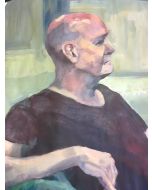Anatomical life and portrait drawing

Choose a start date
- Course Code: VH786
- Dates: 21/05/24 - 09/07/24
- Time: 18:00 - 21:00
- Taught: Tue, Evening
- Duration: 8 sessions (over 8 weeks)
- Location: Keeley Street
- Tutor: Andrea Voisey
Course Code: VH786
Choose a start date
Duration: 8 sessions (over 8 weeks)
Please note: We offer a wide variety of financial support to make courses affordable. Just visit our online Help Centre for more information on a range of topics including fees, online learning and FAQs.
What is the course about?
To anatomize is to take something apart. This course aims to give you a basic grounding in how anatomical structures affect surface forms of the body and how to work this knowledge into your drawing practice.
This course focuses on both portrait and life drawing. However, the issues that effect portraiture and those that effect life drawing are somewhat different. The structure of the human head, and in particular, the face, is a broad subject in its own right. Therefore, we will spend roughly the same amount of time focusing on the head and neck, as we will on the figure as a whole.
The unifying theme will be to understand how superficial anatomical structures (i.e. bone and muscle) influence form, rotation, proportion and likeness. Emphasis will be on working from observation.
What will we cover?
- Proportion
- Rotation
- Weight & balance
- Uniquely human anatomical characteristics
- How form is dictated by underlying bony structures
- How form is dictated by underlying muscle and fat
- Musculature in terms of its role in gesture and motion
- Investigate what makes a figure appear masculine or feminine or young or old.
- Individual characteristics that denote likeness.
What will I achieve?
By the end of this course you should be able to...
- Differentiate between artistic and medical anatomy
- Better understand proportion, rotation and balance
- Draw a portrait from a variety of angles taking into account the basic anatomical structures of the head and neck
- Grasp how the superficial structures expand and contract depending on their position and force exerted upon them
- An improved understanding of what is going on beneath the surface of the skin that will inform the way you approach drawing form
- Begin to produce life drawings with a more informed eye for human anatomy that will become more evidential as the course and your practice progresses.
What level is the course and do I need any particular skills?
Experience of drawing from the life model would be extremely useful, although you are not expected to have any previous experience of studying anatomy.
You should be able to follow simple written and verbal instructions and also be able to take short written notes to support demonstrations and hand-outs. You will be invited to take part in group discussions, mainly in the form of “show and tell”.
How will I be taught, and will there be any work outside the class?
Talks, practical work, demonstrations, individual tutoring and group discussion. You will be encouraged to visit medical collections to draw from their specimens. The emphasis will be on observational drawing.
Are there any other costs? Is there anything I need to bring?
All basic materials are provided.
An A4 (or similar) sketchbook would be useful if you wish to take written or visual notes during demonstrations.
When I've finished, what course can I do next?
Further life drawing and painting courses as advised by your tutor possibilities include;
Portaits 1
Portraits 2
Life Drawing: a Contemporary Approach
Life Drawing: an Experimental Approach
Life Drawing into Painting
VH753 City Lit Year of the Figure and Portrait.
Andrea studied Drawing at Camberwell College and textiles at Morley College, where she also did her teacher training. She has a passion for the macabre and much of her recent practice has focused on drawing animal skulls and skeletons. She has a particular interest in comparative anatomy which led her to devise the Anatomical Life and Portrait Drawing courses at City Lit. Observational drawing is at the core of her practice and she uses it as a means of recording the world around her, be it the clutter of the studio, a music gig or a specimen in a museum. Andrea has an energetic approach to teaching. She is highly communicative and strives to create a positive group dynamic whilst being sensitive to the needs of individual students. This has been enriched by her extensive experience as a life model which she has used as a unique opportunity to observe first-hand the teaching methods and creative processes of many artists and has applied this knowledge to develop her own distinctive teaching style. Examples of her work can be found at www.instagram.com/voiseydrawing
Please note: We reserve the right to change our tutors from those advertised. This happens rarely, but if it does, we are unable to refund fees due to this. Our tutors may have different teaching styles; however we guarantee a consistent quality of teaching in all our courses.


